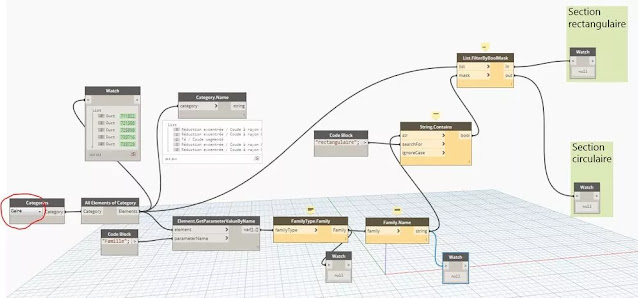What is Dynamo for Revit? 👀
In General, We believe that softwares and programs you learned in university or whatever your company uses are what you stick with. However, it’s frequently advantageous to step out of your comfort zone and explore your options to see what else is out there. New software can deliver chances to facilitate existing workflows or even carry new digital abilities to you and your business.
One of these programs is Dynamo, a plug-in for Revit. Dynamo is an open-source visual programming language for Autodesk Revit, written by engineers and construction experts. It is a programming tool that permits you to type lines of codes and scripts, while also developing an algorithm that consists of nodes.
If you are not friendly with Dynamo yet, you can take a free basic course from DiRoots to learn some basics and how to use Dynamo first, or navigate through some practices videos on dynamobim.org .
Dynamo is a visual programming tool that functions with Autodesk Revit. Dynamo enhances the ability of Revit by delivering access to the Revit API, which stands for Application Programming Interface, more handily. Instead of typing codes, Dynamo helps you create programs by using graphic elements called “nodes”. It’s a method of programming better appropriate for visually oriented types, like architects and engineers, or even BIM developers.

Besides, in Dynamo each node performs an exact job. Nodes have inputs and outputs. These outputs from one node are linked with inputs on another with “wires”. The program or “graph” streams from node to node through the web of wires. The outcome is a graphic illustration of the stages required to accomplish the end design.

One of the powers of visual programming using Dynamo, particularly, is ready access to a place called the library of nodes. So instead of having to recognize the exact code, all you need to do is to type a certain task in your search bar and browse the library to locate the node you need.
Alike, a contributing characteristic to Dynamo’s success is their user community. Besides providing support on its forum, Dynamo users can also make node libraries called “packages” and share them in central storage. This storage can be searched straight from inside of Dynamo. To install these packages, simply click on download and it will install straight into Dynamo.
In addition, what’s remarkable about user-created packages is that they frequently decrypt very specific issues. for example, you are trying to renumber your rooms according to a particular sequence. There’s a node for that! creating piping from lines? There’s a node for that also!
all you need to do is to search for your node and use it, that’s it!
Who can use Dynamo to solve problems for Revit?
Dynamo users are in most cases Architects, Engineers, and Construction experts, so the issues that Dynamo solves are practically related to parametric modeling, BIM data analysis, automation of several daily or weekly tasks like documentation, Information Exchange, Data Management, and here are some benefits of integrating Dynamo into your day-to-day workflow
#1 BIM Data Management
What really matters from the word BIM is the “I”. Despite getting that Information is not as easy as it must be. Of course, you can create schedules in Revit. Also, you can even import and export these schedules from and to MS Excel. But occasionally you have to combine data from different categories and databases. Or even you need to figure specific values. While Autodesk Revit has a lot of improvement in these abilities, it still fails on many data tasks.

However, Dynamo in Revit makes this procedure considerably more comfortable. So can export your data into MS Excel, MS Access and use these files into MS PowerBI Presentation to examine your Data and create your Project BIM Dashboard.
#2 Automation
Revit usage seems sometimes boring because of repetitive tasks. Sure, Autodesk Revit completes unique tasks so easy to achieve. But when you must do this specific task more than 100 times, it became boring and boring.

let’s take the example of Creating sheets. Creating a sheet in Revit is not very difficult. All it takes is a couple of clicks and boom your sheet is created. But in several cases, you need to create more than 100 new sheets. So we are not talking about a couple of clicks but thousands of them.
Fortunately, Dynamo in Revit makes this task a piece of cake. You can create your sheets directly in the model from plans and views. Or even create them from a CSV file. It’s all about automation.
There are thousands of tasks that you can automate with Dynamo in Revit. Simply you need to perform a specific task more than 3 times a day and that task takes more than a minute to complete, it’s mature for automation.
#3 BIM Design – Parametric Modelling
In addition to BIM data Management and Automation, Dynamo is also a strong design tool. With Dynamo, the design really becomes a process as you explicitly describe the generative design rules.

It’s possible to generate hundreds of options using these rules.
This use of Dynamo as a design tool is not restricted only to twisting towers or wild geometry. Also, you could use it to develop random glazing patterns on curtain walls. Layout MEP and Systems rooms. Or layout furniture in a typical Space. Really, there are thousands of design-related applications for Dynamo.
#4 BIM Analysis
The analysis comes in the study phase of a construction project, where Engineers are meant to evaluate the building performance before its built. and here is where Dynamo comes. Because it makes it more manageable to simulate building performance throughout the design stage. You can make your solar analysis, loads analysis, energy consumption analysis with the help of Dynamo in Revit.

Dynamo also provides a way to evaluate designs based on objective criteria. Also, it helps engineers efficiently determine which design performs better to choose an optimal solution. Dynamo provides a tool for making this decision throughout the design stage more easily and according to an exact analysis and not just when the construction is done.
#5 Computational Thinking
Finally, Dynamo needs you to take a methodical strategy to work. You have to think logically and in a step-by-step way. Most designers rely on creativity to solve issues. This kind of thinking doesn’t continually work. But what if you could wisely use this instinct? You could look at each step and truly comprehend what makes it work. Even sufficiently, you could reuse that design sense and improve it again and again.

By utilizing this computational thinking, you are encoding the model and the workflow. Each step becomes a sequence of pedagogy that can be reckoned, reviewed, and enhanced. Correspondingly, each step needs exact parameters. It’s one less problem you need to crack so you can get on with the more significant result!
Did you enjoy this article? Do you want to get even more pieces of information about what is Dynamo for Revit and BIM? Subscribe to our newsletter and Check out our YouTube channel and leave us your feedback down below.



